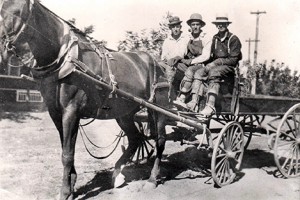
Crew working in PG&E Desabla Division in early 20th century. The 1910 IBEW contract provided for wage hikes and an allowance for the keep of a horse and wagon. Pacific Gas & Electric
The Pacific District Council was aligned with the Reid IBEW. From 1909 to 1912, the Council bargained some 30 agreements for 7,000 IBEW members at 56 local unions. In 1910 the Council negotiated wage increases for PG&E electric classifications. That agreement also provided a closed shop and an expense allowance for the keep of a horse and wagon. Similar provisions were negotiated in 1912. With 700 members in 1912, Local 151 was the largest local in the Reid IBEW.
In 1911 Local 151 helped craft bills regulating overhead and underground electric construction in California. Over the strenuous protests of the Merchants’ and Manufacturers’ Association of Los Angeles, the bills were signed into law by Gov. Hiram Johnson.
Around this same time, United Railroads was pressuring San Francisco for outsized concessions to expand the transit system for the upcoming World’s Fair. In a slap at its old enemy, Local 151 joined others in proposing that any such transit facilities should revert to municipal ownership at the Fair’s conclusion. United Railroads’ grip on San Francisco was broken, giving way to the municipal transit system known today as Muni.
In March of 1912, the IBEW Pacific District Council incorporated gas workers into the labor agreement with PG&E—a further step toward unity. With a new round of negotiations coming up in early 1913, the top leaders of the Pacific District Council believed they could bring all PG&E crafts into one organization and present a united front at the bargaining table. The workers wanted more power. PG&E was not enthusiastic about this idea.